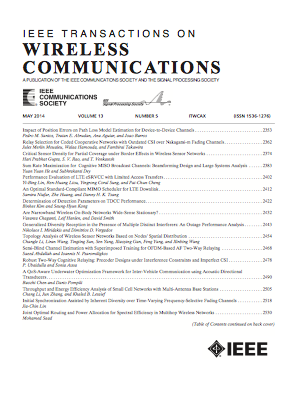RIS Assisted Radar-Communication Coexistence System With Discrete Reflection Coefficients
IF 10.7
1区 计算机科学
Q1 ENGINEERING, ELECTRICAL & ELECTRONIC
引用次数: 0
Abstract
The advent of reconfigurable intelligent surfaces (RIS) introduces a novel paradigm to address mutual interference issues within radar-communication coexistence (RCC) systems. However, the predominantly discrete reflection coefficients (DRC) of most real-world RISs pose new challenges for the design of interference-mitigating reflection coefficients. This paper investigates a RIS-assisted RCC system with DRC. First, a radar SINR maximization problem under the constraints of communication signal-to-interference plus noise ratio (SINR) requirements is formulated to obtain feasible designs for the DRC and radar beamforming vectors. Then, an alternating optimization approach is applied, decomposing the original problem into two sub-problems. For the DRC optimization sub-problem, a design approach based on semidefinite relaxation (SDR) and Gaussian randomization is proposed. For the radar beamforming sub-problem, the closed-form expressions for the optimal radar beamforming vectors are obtained by the generalized Rayleigh quotient and the Karush-Kuhn-Tucker (KKT) conditions. Finally, it is demonstrated that within a communication-centric scenario, the RIS needs to maintain orthogonality between the interference channel and the radar-target channel in order to achieve the upper bound of the radar SINR. Based on this conclusion, a low-complexity approach is proposed to optimize the radar SINR in a communication-centric scenario.RIS辅助的离散反射系数雷达通信共存系统
可重构智能表面(RIS)的出现引入了一种新的范式来解决雷达-通信共存(RCC)系统中的相互干扰问题。然而,现实世界中大多数RISs的离散反射系数(DRC)对抗干扰反射系数的设计提出了新的挑战。本文研究了一种具有DRC的ris辅助RCC系统。首先,提出了在通信信噪比(SINR)要求约束下的雷达SINR最大化问题,以获得DRC和雷达波束形成矢量的可行设计。然后,采用交替优化方法,将原问题分解为两个子问题。针对DRC优化子问题,提出了一种基于半定松弛和高斯随机化的设计方法。对于雷达波束形成子问题,利用广义瑞利商和KKT条件,得到了最优雷达波束形成矢量的封闭表达式。最后,证明了在以通信为中心的场景中,RIS需要保持干扰信道和雷达目标信道之间的正交性,以实现雷达SINR的上界。在此基础上,提出了一种以通信为中心的低复杂度方法来优化雷达信噪比。
本文章由计算机程序翻译,如有差异,请以英文原文为准。
求助全文
约1分钟内获得全文
求助全文
来源期刊
CiteScore
18.60
自引率
10.60%
发文量
708
审稿时长
5.6 months
期刊介绍:
The IEEE Transactions on Wireless Communications is a prestigious publication that showcases cutting-edge advancements in wireless communications. It welcomes both theoretical and practical contributions in various areas. The scope of the Transactions encompasses a wide range of topics, including modulation and coding, detection and estimation, propagation and channel characterization, and diversity techniques. The journal also emphasizes the physical and link layer communication aspects of network architectures and protocols.
The journal is open to papers on specific topics or non-traditional topics related to specific application areas. This includes simulation tools and methodologies, orthogonal frequency division multiplexing, MIMO systems, and wireless over optical technologies.
Overall, the IEEE Transactions on Wireless Communications serves as a platform for high-quality manuscripts that push the boundaries of wireless communications and contribute to advancements in the field.

 求助内容:
求助内容: 应助结果提醒方式:
应助结果提醒方式:


